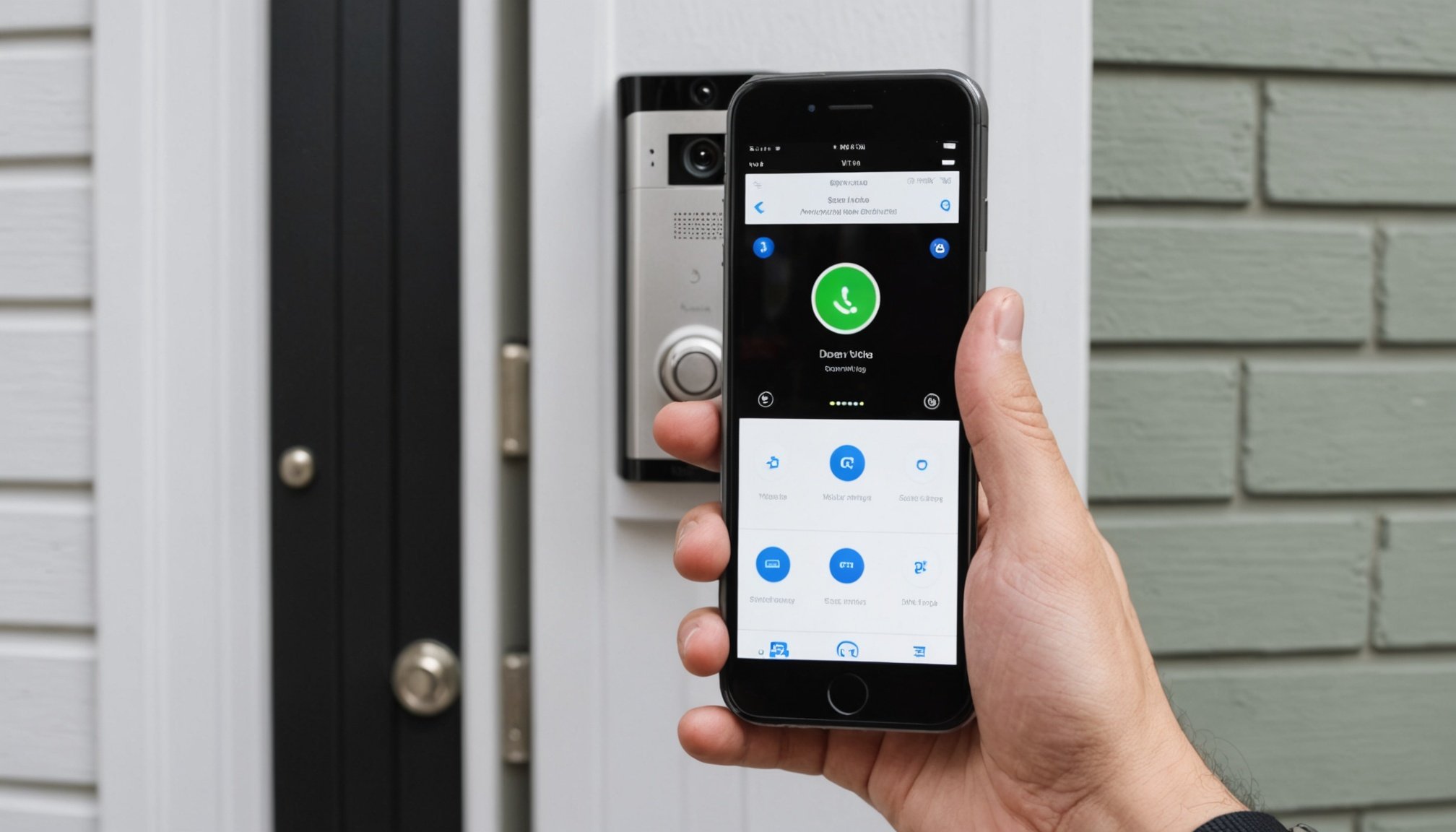Preparing for Installation
Before setting up your smart video doorbell, it is crucial to ensure that your smartphone is compatible with the device. Most video doorbells require a specific smartphone setup, which typically involves downloading a companion app compatible with iOS or Android operating systems. Always check the doorbell’s specifications to confirm compatibility with your smartphone model.
For a seamless installation process, gather the necessary tools and materials beforehand. You’ll likely need a screwdriver, drill, screws, and wall anchors if installing on a solid surface. Some video doorbell packages include the necessary tools, so verify contents before acquiring additional items.
Topic to read : Master your smart home: use your smartphone for effortless voice control of appliances
Safety should be your top priority when preparing for installation. Begin by turning off power to your existing doorbell system to prevent any electrical accidents. Additionally, if you’re unsure about the electrical work involved, consulting a professional is advisable for safe installation.
H3 – Recommended Safety Precautions
- Disconnect power supply to avoid electric shocks.
- Use a stable ladder if installing at a height.
- Ensure all tools are in good condition.
- Follow the manufacturer’s instructions for a secure fit.
By considering compatibility, collecting essential tools, and taking safety precautions, you can set the stage for a successful smart video doorbell installation.
Also to discover : Empowering elderly care: transform your smartphone into a smart home management hub
Downloading Necessary Applications
Setting up a smart video doorbell is straightforward, thanks to various app installation processes designed to guide users at each stage.
Identifying the Correct App
First, identify the appropriate video doorbell app for your device. Many brands offer proprietary applications, frequently named similarly to the product itself. Consult the user manual for the correct app name for your doorbell model, ensuring compatibility with your smartphone’s operating system—either iOS or Android. It’s vital to use the official app to guarantee proper functionality and updates.
Downloading and Installing the App
Once you have identified the correct app, proceed to download it from the appropriate store—App Store for iOS users or Google Play Store for Android users. Simply search for the app using the name found in your manual. Once located, tap “Install” or “Get,” then wait for the installation to complete. This step is generally hassle-free, and the app icon will appear on your home screen.
Creating an Account or Signing In
With the app installed, the next step involves setting up an account or signing in. For first-time users, select “Create Account” and follow on-screen instructions, typically involving entering your email, creating a password, and verifying your identity. Existing users can simply sign in with pre-existing credentials, expediting the setup process.
Connecting the Smart Video Doorbell to Your Smartphone
Embarking on a mission to enhance your home security with a smart video doorbell? Connecting it to your smartphone is essential. First, ensure the Wi-Fi compatibility of your device. Most video doorbells require a 2.4GHz network rather than a 5GHz one. Having confirmed compatibility, proceed to the wireless setup.
Begin by downloading the doorbell’s app on your smartphone. Follow the in-app instructions to pair the smart video doorbell with your phone. Typically, this involves scanning a QR code displayed on your smartphone or pressing a button on the doorbell. This process allows your phone to communicate seamlessly with the device, providing real-time notifications and access to recorded footage.
However, connectivity issues are not uncommon. If you encounter problems, confirm that the doorbell is within range of the router. Interference from walls and other devices can also impede the signal. Resetting the router or the device is often the quickest way to re-establish a connection. Use an app-based diagnostic tool, if available, to identify and troubleshoot any irregularities.
A stable device connection isn’t just about seamless communication; it also ensures your peace of mind regarding home security.
Configuring Settings and Features
Setting up your video doorbell‘s settings and configuration is essential for optimal performance. This involves tweaking various options to ensure your device functions exactly how you want it to.
Accessing the Settings Menu
To begin, navigate through the app to access the settings menu. This is typically done by tapping on the gear icon or a similarly marked button within the app. Here, you’ll find various options to customize your video doorbell, making it uniquely suited to your situation.
Customizing Alerts and Notifications
It’s crucial to customize alerts and notifications to suit your specific needs. You might prefer receiving alerts only during certain hours or under specific conditions. Configuring these settings allows you to manage the inundation of information more effectively, ensuring you receive pertinent updates without unnecessary disruptions.
Adjusting Camera Angle and Sensitivity
Properly positioning your camera is vital for adequate coverage. Adjust the camera angle and sensitivity to capture the most relevant video footage. The settings allow you to fine-tune the perspective and detection range, ensuring the camera doesn’t capture unnecessary activities. This not only optimizes the storage space but also focuses on potential security breaches.
Testing the Smart Video Doorbell
Ensuring that your smart video doorbell is functioning optimally starts with a proper testing setup. Once securely installed, you’ll want to conduct a functionality test to confirm that all features are operational. Begin by examining the device’s connectivity to your home network. This checks if your doorbell is linked properly to your Wi-Fi, a key factor for seamless performance and video quality.
Next, perform a performance check for both video and audio. Evaluate the footage to confirm that live streaming is clear and without delays. The audio should be crisp, allowing you to communicate clearly with visitors. Using a variety of light conditions during testing will also ensure that night vision capabilities are effective.
Troubleshooting is an integral part of ensuring everything is running smoothly. Address common issues such as lagging video or poor audio output by first looking into your Wi-Fi signal strength. Additionally, ensure the firmware is up-to-date, as updates often include performance enhancements.
If problems persist, refer to the manufacturer’s guide for troubleshooting tips or consider contacting customer support. By maintaining a systemised approach towards testing, you ensure reliable performance from your smart video doorbell.
FAQs and Troubleshooting
When dealing with common issues during setup, having clear guidance is crucial. Below, we address frequently asked questions and offer solutions to frequent problems.
Frequently Asked Questions on Setup
-
How do I reset my device if it’s not responding?
To reset, hold down the power button for 10 seconds until the device restarts. This often clears minor glitches and restores normal functions.
-
Can I set up multiple devices?
Yes, most systems support multiple device setups. Follow the user manual step-by-step for each device to ensure a smooth installation process.
Addressing Common Problems
- Connectivity Issues: Ensure your Wi-Fi network is strong and devices are within range. Restarting the router can also help.
- Software Updates: Regular updates prevent glitches. Check for updates in the settings menu regularly.
- Unexpected Errors: Often caused by outdated firmware; updating can resolve these. If issues persist, consider reinstalling the software.
When to Contact Customer Support
It’s time to reach out to customer support if:
- The device doesn’t respond after a reset.
- There are unresolved connectivity issues.
- Persistent software errors occur despite updates.
Customer service can provide more specific solutions and professional guidance to address these challenges.






